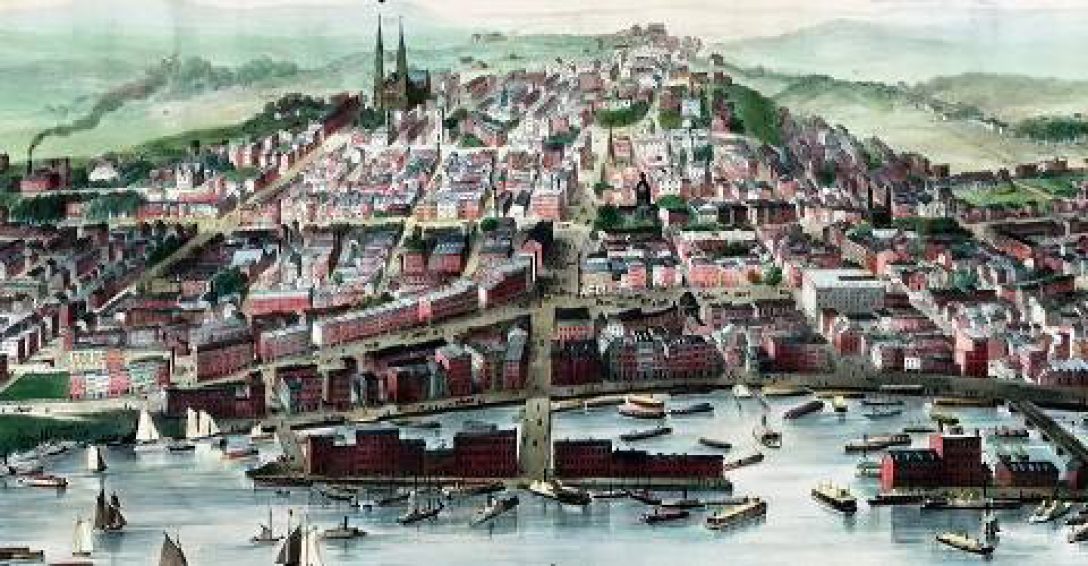
Thomas Elkins was one of the most fascinating African-American men in Albany in the 19th century. He was born about 1819 in New York City. He came to Albany with his parents in the 1820s, and when in his early teens served as an apprentice to the druggist Herman Wynkoop at Wynkoop’s shop at Broadway and Maiden Lane (living in Wynkoop’s home at 14 Orange St.).*
Following his apprenticeship with Wynkoop he studied with a local dentist. (His obituary said they were associated in practice in Montreal and then Saratoga.)
Unlike other local African American men in Albany of the time Elkins was not opposed to the colonization movement. In 1847, when he was 28, he sailed to Liberia under the auspices of the Maryland Colonization Society. In 1848 Frederick Douglass’ newspaper “The North Star “reported he was also serving as a school superintendent as well as practicing dentistry.
Upon his return he entered into the study of medicine with Dr. Alden March, founder of Albany Medical College, and professor Dr. Thomas Hun. (There’s a reference in the “The North Star” to as student from Liberia, c. 1850, studying at the College – we believe that is Dr. Elkins.)
By 1850 Elkins is listed as a practicing dentist at 188 Lumber St. (now Livingston Ave.), home of his step-father, John Butler, his mother Sarah and his half-sisters. By 1852, he’s set up his own shop at 84 North Swan St., around the corner, and he’s still living at home with his mother who has become a widow. In 1855 he moved his apothecary shop to 790 Broadway (where he would remain for decades in the same general location). It was about this time he was appointed by Albany’s Mayor Nolan to be a city district physician.
It was also at this time he became politically active. Elkins is identified as the Secretary/Treasurer of the Vigilance Committee tasked with raising funds for the Underground Railroad (UGRR). During the Civil War he was appointed by Massachusetts Governor John Andrew as medical examiner for the recruits for the 54th Massachusetts “colored” regiment (you know it from the movie ‘Glory”), and the 55th regiment created to handle the overflow influx of African-American recruits.

Just after the War his mother dies and Elkins moves his residence to 67 Second St. near North Swan St. He also plunged into social and political activities. He attends the New York State Colored Convention in Albany in 1866, becomes the Vice President of the newly formed African American Literary Society (for men only), immerses himself in Republican politics (the 15th amendment granting African American men the right to votes was passed n 1870), and becomes part of a coalition to pressure the Albany Board of Education to integrate the High School. He’s an active member of the County Dental Society.


And he tinkers. Over about a decade he patents 3 inventions; the first was a quilting/ironing table The second invention was the most splendiferous commode you’ve ever seen – a veritable throne. His final patent was for the technology of one of the earliest refrigeration units (patent number 221,222 in 1879).


And over the next two decades his was a life well lived. He continues to practice, participates in the social and activities of the African –American Albany (he’s the first African –American to serve on a federal grand jury in Albany County).
Dr Elkins died in August 1900. His funeral at the Cathedral of All-Saints was thronged, and his pall bearers were the sons of Francis Van Vranken, his closest friend – a barber – who had been a member of the UGRR.
One of the newspaper obituaries makes it quite clear that, but for his race he would have become a licensed physician (although he was treated as if he was by most of Albany, including the police and the courts).
“‘Prejudice alone at his color has prevented him making a competence at his profession, as he is in the opinion of many competent to judge, one of the ablest physicians and dentists of this or any other age, either in this city or elsewhere”
*Wynkoop was related to high society of New York – the Lansings and the Gansevoorts, which probably opened doors for Elkins that would have been otherwise closed.


[…] Dr. Thomas Elkins, one of Albany’s most fascinating African Americans of the 19th century, proposed to donate an elm tree to be planted on behalf of the community, “as a memorial of the colored citizens.” At a meeting of a large number of Black residents at the African Methodist Episcopal Church on June 16, 1886, led by J.F. Chapman, Robert McIntyre, representing the Burdett-Coutts Association, was authorized to secure permission to plant the tree in Washington Park. Burdett-Coutts would also parade, “and had invited the Nemo club, of New York city, as their guests.” […]
LikeLike